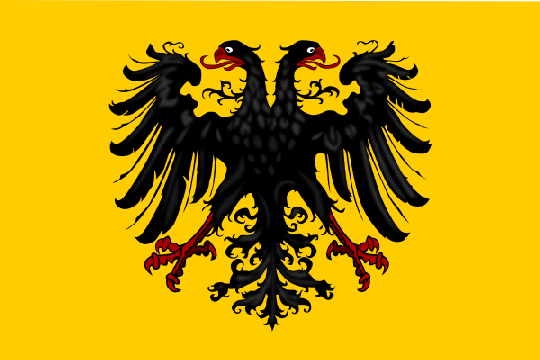
 image by Albrecht Altdorfer, 26 June 2010
image by Albrecht Altdorfer, 26 June 2010
flag of Holy Roman Empire around 1400

Last modified: 2014-03-30 by klaus-michael schneider
Keywords: bayern | bavaria | mainz(archbishopric) | wuerzburg(bishopric) | hohenzollern | zollern | bamberg(bishopric) | palatinate |
Links: FOTW homepage |
search |
disclaimer and copyright |
write us |
mirrors
Since county coat of arms are the most distinctive feature of the flags, explanations on them seem appropriate. Most of the designs feature elements symbolizing historical states (often pre-1803) which the counties' areas once belonged to, combined with 'local' symbols for distinction. Here is a short overview of the most common symbols.
![[Bavaria, flag with lozenges (Germany)]](../images/d/de-by2c.gif) image by M. Schmöger
image by M. Schmöger
Bavaria: lozengy of white and blue; These are the arms of the Wittelsbach family that ruled Bavaria for nearly a millenium until the monarchies in Germany were abolished in 1918. The arms were inherited by the Wittelsbachs from the counts of Bogen - whose possessions were near the Danube river around Regensburg - in the 13th century. Lozenges in county coat of arms are thus often used to indicate that the area of the county has belonged to Bavaria for long times and are more commonly found in the southern and eastern parts of Bavaria - Upper and Lower Bavaria and Upper Palatinate -. In the areas of Franconia and Swabia (north and western parts) other symbols take precedence as these areas were added to Bavaria between 1803 and 1816 - in fact, some people in those areas tend to insist that they are not Bavarians at all.
![[Mainz (Rhineland-Palatinate, Germany)]](../images/d/de_magun.gif)
 image by Jaume Ollé
image by Jaume Ollé
Archbishopric of Mainz: white wheel in a red field: The archbishops of Mainz were important rulers in central Germany - e.g. the bishop was one of the seven electors of the emperor - and owned large possessions, including some in Lower Franconia in the northwest of Bavaria; these were added to Bavaria during or in the aftermath of the Napoleonic Wars. The origin of the wheel is not known. It is also present in the arms (and flag) of Rhineland-Palatinate (where the city of Mainz is located).
![[Franconia, flag with coat-of-arms (Bavaria, Germany)]](../images/d/de-by-fk.gif) image by M. Schmöger
image by M. Schmöger
Bishopric of Würzburg / Franconia: three white points in a red field: The bishops of Würzburg also held many estates mainly in Lower Franconia. The bishopric came under Bavarian rule in 1803/1815. In 1835 its arms were included in the arms of Bavaria to symbolize the Franconian parts of the (then) Kingdom. Since then the points - also called Rechen, rake, in German - have come to be seen as a symbol for Franconia as a whole - i.e. not just the parts previously under the rule of Würzburg.

 image by Albrecht Altdorfer, 26 June 2010
image by Albrecht Altdorfer, 26 June 2010
flag of Holy Roman Empire around 1400
Imperial cities: black (double-headed) eagle in a gold field: Some Coat of Arms feature the imperial eagle, mostly to symbolize the presence of former imperial cities within the county. These were cities not belonging to any lordship, but directly subordinate to the emperor. In the area today covered by Bavaria, these were Nürnberg, Schweinfurt, (Bad) Windsheim, Rothenburg/Tauber, Dinkelsbühl and Weißenburg (at a time also Feuchtwangen). Their independence ended in 1803/1806. The arms are best seen on the flag of Hechingen in Baden-Württemberg.
![[Hechingen city flag]](../images/d/de-bl-he.gif)
 image by Klaus-Michael Schneider, 17 Sep 2010
image by Klaus-Michael Schneider, 17 Sep 2010
Zollern: quartered of white and black: The Zollern family, originally located in Swabia, became Burggraves of Nürnberg in 1191 and acquired further territories (Ansbach, Bayreuth, Kulmbach) in the 14th century. Hence, a considerable portion of what is today Central and Upper Franconia (the northern part of Bavaria) was then under their rule. In 1417, they also became Electors of Brandenburg, and assumed the arms of Brandenburg (the red eagle). Hence, a number of county Coat of Arms also show the eagle (e.g. Bayreuth).
![[Bamberg County (Oberfranken District, Bavaria, Germany)]](../images/d/de-ba.gif) 3:5
3:5 
Bishopric of Bamberg: black lion in a golden field and covered by a thin white bend: The territories of the prince-bishops of Bamberg were located in what is now roughly the western part of Upper Franconia, the area around Bamberg. The bend is probably for distinction from similar arms, e.g. those of Salzburg. The bishopric became a part of Bavaria in 1803.
![[Palatinate 14th-18th centuries (Rhineland-Palatinate, Germany)]](../images/d/de_palre.gif)
 image by Jaume Ollé
image by Jaume Ollé
Palatinate (Pfalz): yellow lion, crowned and armed red, in a black field: The Palatinate was a county with various splintered possessions along the Rhine. Originally it was ruled by the Staufen family; from their arms the lion is derived. The prince of the Palatinate was the chairman in the council of Electors of the emperor - the lion's crown symbolizes this privilege. In 1214 the Wittelsbachs, the rulers of Bavaria, acquired the county, and - apart from various territorial changes - it remained a part of Bavaria, though separated from the rest of its territory, until 1945. In 1329 the Wittelsbach split their territories into two lines - Ludwig's line took Bavaria proper, and Rudolf's line the Palatinate and the northern part of the Duchy - which became in the course of time known as the
Upper Palatinate (Oberpfalz) - today the eastern part of Bavaria. In 1777 the two lines and their territories merged again. The lion plays a part in the heraldry of the
Upper Palatinate and other territories held by the Rudolfian line (e.g. Neuburg). It also appears in the large state arms of Bavaria, and moreover in those of Baden-Württemberg, Rhineland-Palatinate and Saarland.
Stefan Schwoon, 21 Sep 2001
back to Bavarian District, County and Municipal Flags page click here